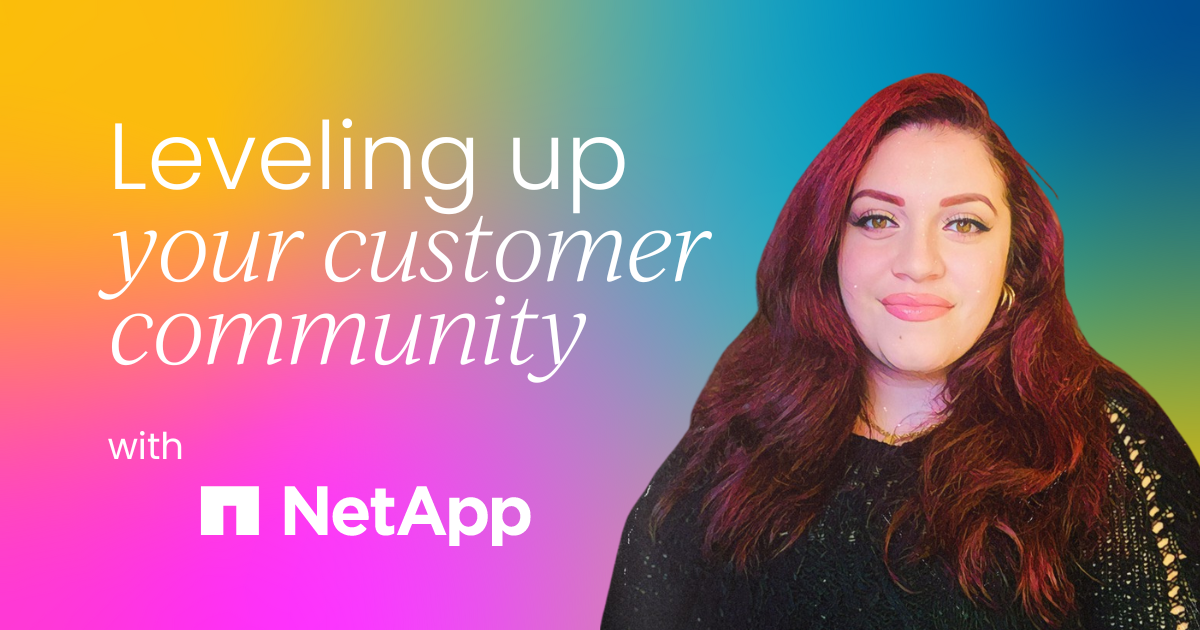No company can thrive without community. It’s the connective tissue between customers and businesses, transforming users from passive consumers into engaged advocates.
From online forums and ambassador programs to exclusive events and organic knowledge sharing, community-building is the invisible force that drives customer loyalty, retention, and brand advocacy.
For such a crucial function, it begs the question: what actually makes a great multifaceted community program?
In this guide, we’re going to cover:
- What makes a community multifaceted?
- Best practices for building a multifaceted community
- Navigating the challenges of a global community
- Common pitfalls to avoid when building a community
- Demonstrating the business impact of community
Let’s dive in.
What makes a community multifaceted?
Community-building as a profession is in a similar place today as fields like customer success were about 10–15 years ago.
Back then, businesses had their sales team and their support team. They will have had account managers thrown into the mix, but the concept of a dedicated function for ensuring your customers' success? It was a pretty alien concept.
Now, customer success is a given for any service-oriented business. It's not just a department; customer-centricity is a business strategy that entire companies need to get behind. And community is bolting in the same direction.
Rewind a good 10 years ago, if a company was forward-thinking enough to have an online community, chances are they viewed it as nothing more than a support forum. It was a reductive viewpoint. Of course, forums are useful, there's no knocking them. But a true community program should be far more expansive.
You see, a multifaceted community is designed to go beyond problem-solving—it’s about creating meaningful engagement touchpoints across different platforms and formats.
A robust community should:
- Provide a space for engaged and passionate users to connect
- Enable both online and offline interactions
- Offer multiple channels for interaction beyond just a forum
- Support customers throughout their journey, not just when they have problems
If all a company does is host a support forum, they’re only serving a small subset of their audience. But there’s a much larger group that wants to engage differently. That’s where a multifaceted approach comes in.
Avoiding the pitfalls of one-dimensional communities
Many B2B communities mistakenly replicate a B2C-style forum model. In B2B, customers seek solutions and leave once their problem is resolved. This transactional approach results in low-return engagement. If your primary goal is to reduce support costs, you're in it for the wrong reason.
To avoid this, businesses must shift their focus from cost reduction (via ticket deflection) to value creation.
A thriving community includes:
- Learning opportunities (best practices, industry insights).
- Peer-to-peer connections that encourage collaboration.
- Recognition programs to celebrate contributions.
- Exclusive access to content, events, and discussions.
When you get people excited and give them more places to go and more things to talk about beyond just "I have this problem, help me solve it," that’s when you truly build deep customer engagement.

Creating spaces for connection beyond problem-solving
One of the most powerful things a community can do is provide members with opportunities to connect beyond just solving problems. When a community moves from being purely a support channel to a space where people engage proactively, it transforms into something much greater.
As Ari Hoffman, an expert in customer advocacy and community engagement, points out:
“It’s about connecting with each other. It’s about getting inspired by each other. It’s about learning from each other. It’s the FOMO – the fear of missing out– that social separation you create. It’s all of it. A community should make people feel like they’re part of something bigger.”
This is especially important in B2B, which can sometimes feel dry or transactional. But at the end of the day, people still want to feel a sense of belonging. Even with a workplace productivity tool like Asana, users are deeply interested in improving how they work. Beneath the surface, there’s a strong desire to learn, share insights, and celebrate efficiency.
When you create the right framework and channels for people to share ideas, they inspire each other. They celebrate successes together. They push each other to improve.
The intersection of community and customer marketing
For customer marketers and advocacy professionals, understanding how community fits into their strategy is essential. As Ari noted, community-led growth (CLG) is real, and companies that get it right reap major benefits.
Customer marketing, advocacy, and community management all serve the same goal: engaging and empowering customers. The difference is in how they approach it.
These functions are really closely related. They’re just often targeting different segments of the customer base. At Asana, I worked very closely with our customer marketing team. We’re all customer-facing, and we’re all trying to get people engaged in different ways. When we align our strategies, we achieve more.

Best practices for building a multifaceted community
1. Meet your customers where they are
One of the most fundamental principles of community-building is understanding where your customers already engage. Instead of forcing them onto a new platform, find out what tools and channels they are already using.
At Asana, we simply asked our community: “If we were to start more channels for you, where would you like us to be?” Their feedback helped us decide where to focus our efforts and, just as importantly, where not to spend time.
2. Make participation valuable (and fun)
Your customers are busy. They don’t need yet another place to go.
Once you establish the right channels, the next step is ensuring that community members get immediate value from participating. This could take many forms, depending on what your company offers and what your members find useful.
Some of the ways we add value include:
- Educational opportunities: Exclusive training sessions, workshops, or webinars
- Early access: Previewing new features before they launch
- Community challenges: Encouraging users to submit templates, workflows, or success stories
- Celebration and recognition: Showcasing member contributions and achievements
3. Integrate community with customer advocacy
One common challenge in organizations is the disconnect between customer marketing, advocacy programs, and community teams. Often, advocacy professionals fear that integrating too much into the community will disrupt engagement, while community managers worry that pushing advocacy programs too hard might feel too “sales-y.”
The best approach is to ensure that advocacy naturally fits within the broader community framework rather than being treated as a separate entity. For example:
- Salesforce’s MVP program was embedded within the community rather than being a separate initiative. Members naturally aspire to be part of it.
- Marketo’s purple select was built within the existing Marketo community, ensuring that engaged members had a clear path to becoming advocates.
As I put it, “If you already have a community, think of it as a big tent. There are different spaces within it for different needs, but you don’t need to build an entirely new tent just for advocacy.”
4. Adapt to changing communication preferences
As we look to the future, community teams need to adapt to the communication habits of new generations. Gen Z, for example, engages on entirely different platforms than previous generations.
With Gen Z moving into the workforce, we need to ask: What channels are they on? Are we going to see B2B communities on Discord or Twitch? We’ve grown comfortable with certain platforms, but we need to meet this new generation where they are.
Involving younger community members in the decision-making process ensures authenticity. Nothing is more cringe-worthy than trying to build engagement on a platform you don’t fully understand. That’s why diversity on community teams—including generational diversity—is key to staying relevant and reaching a global audience effectively.

Navigating the challenges of a global community
1. Be realistic about your team’s capabilities
Managing a global community with a small team is a challenge many organizations face. The reality is that if your community team is based in one-time zone and speaks only one language, you won’t be able to support every user 24/7 in their preferred language. Instead of over-promising, it’s crucial to set clear expectations.
You don’t have to hide things from people. If your team can only engage in English, say so clearly within the community. Be upfront about your limitations while looking for creative solutions to bridge the gaps.
One way to address this challenge is to leverage engaged community members. If you can’t offer full multilingual support, consider starting an ambassador program where members fluent in key languages help bridge the communication gap. These ambassadors could:
- Answer a set number of questions per month in the forum
- Host periodic webinars or discussions in their language
- Offer insights into cultural nuances that help tailor community strategies
Of course, asking for help means offering value in return. While these members don’t work for your company, they are motivated by recognition and meaningful exchanges. You could offer them:
- Exclusive access to product teams or leadership for behind-the-scenes insights
- Priority support for their own product-related needs
- Swag, credits, or recognition as a way to celebrate their contributions
The key is to create a mutually beneficial value exchange. Most highly engaged community members want to contribute—but they need clear expectations and incentives to stay involved.

2. Strengthening the link between advocacy and community
Ari Hoffman brings up an excellent point about leveraging advocacy to strengthen global community efforts.
“If you find advocates in different countries who aren’t yet part of the community, introduce them to the community managers. This is a great way for them to advocate in their native language and represent their region organically.”
Even if your company isn’t operating at a multinational scale, this strategy applies on a smaller level. Your most active community members can serve as lighthouses—visible champions who inspire others to participate. Marketing teams can collaborate with community managers to create content that highlights these individuals and their contributions.
The key takeaway? Provide value first before asking for something in return.
3. Understanding different levels of engagement within a business
A crucial distinction in community strategy is recognizing who you’re engaging at different levels of an organization.
At Asana, most customer marketing happened at the executive and VP level, whereas the community is designed for the product users—typically director-level and below.
Many organizations have this structure, with multiple layers of stakeholders. Instead of treating these groups separately, customer marketing and community teams should work together.
For example:
- If a customer marketer is working on a case study with a VP, they should ask: Who are your internal champions using our product?
- Those champions can then be introduced to the community team, where they can be featured in events, discussions, or success stories.
4. Building future advocates within your community
Another powerful advantage of community engagement is planting seeds for the future.
When users engage deeply in a community, they develop strong product affinity. As their careers progress, they may move into leadership roles at new companies—and when they do, they’ll remember the positive experiences they had with your brand.
By having this community available to users, you’re helping them grow. One day, they’ll be decision-makers at another company, and they might choose your product because of their past engagement with your community.
This is why investing in community is a long-term strategy. Today’s community members may be tomorrow’s executive champions. By fostering engagement now, you create brand loyalty that extends beyond a single job or organization.

Common pitfalls to avoid when building a community
1. Starting a community without a clear purpose
One of the biggest red flags I see when advising organizations on community strategy is when decision-makers say, “We need a community,” but they can’t articulate why.
A community isn’t just something a company “should have.” It needs a defined purpose that aligns with both business goals and customer needs. Without this clarity, community efforts risk becoming directionless.
If a community program starts without leadership buy-in or a clear objective, it often falls into a cycle where it’s considered important one quarter and forgotten the next. This is problematic for multiple reasons, but most importantly:
Once you invite people into a community, you can’t abandon them.
If a community loses momentum and engagement declines, it’s incredibly difficult to rebuild trust and participation. As I often say, “Once the train leaves the station, you have to keep it moving. If it stops, it’s not coming back.”
To avoid this pitfall:
- Clearly define why the community exists and what it aims to achieve.
- Establish success metrics from the beginning and track progress.
- Ensure long-term buy-in from decision-makers so resources remain consistent.
2. Making the community solely about business needs
Another common mistake is treating the community purely as a business tool without considering the customer’s perspective.
Yes, a community should drive value for the company—but it must also provide value to its members. If the community feels like a thinly veiled marketing or sales channel, customers will disengage.
There needs to be balance between what the business wants and what customers need. If the program is all about company goals—more engagement, more sales, more referrals—without offering meaningful benefits to the members, customers will quickly see through it.
A thriving community is built on a give-and-get model. Businesses must offer real value—whether through exclusive content, networking opportunities, or product insights—before expecting customers to contribute.
3. Treating community as just a support forum
A common misstep is viewing community through the narrow lens of ticket deflection—only solving customer problems rather than fostering engagement. While customer support forums are valuable, they are only one facet of a well-rounded community.
Instead of framing community as a troubleshooting tool, businesses should focus on celebrating customers, sharing stories, and creating spaces for meaningful interaction.
By shifting the messaging to align with broader marketing and brand narratives, a community becomes a strategic pillar of marketing, rather than just a cost-saving measure for support teams.
4. Ignoring data and operating on gut feeling
Many community professionals lean toward the relationship-building side of engagement—but some struggle with the data side of the equation.
I often hear, “I feel like we should do this” or “I think this would work,” but when I ask for supporting data, there’s hesitation. The best community strategies balance intuition with insights to make informed decisions.
At Asana, we tracked two key types of data:
- Program health metrics: Where are members most active? How frequently do they engage? What type of content or events draw the highest participation?
- Business impact metrics: How does community participation correlate with product adoption, retention, or expansion? Do community members use the product more than non-members?
This data doesn’t just validate the effectiveness of a community program—it also helps secure more resources and executive buy-in.
5. Assuming a community can run itself
Many organizations believe that once a community is built, customers will take over and sustain it. While that’s the end goal, getting to that point requires ongoing investment and management.
To use the train analogy:
- If you stop running the train, the passengers get off.
- Restarting the train later is far more expensive and difficult than keeping it running.
- Once trust is broken, members won’t easily return.
The reality is that community engagement requires constant nurturing—whether through content, events, recognition, or proactive outreach. If businesses aren’t willing to make that commitment, they shouldn’t start a community in the first place.

The role of passive observers in community
1. Understanding the value of lurkers
A common concern in community management is the presence of passive observers—members who engage with content but rarely participate in discussions. Some may log into a forum to read answers but never post, while others might attend webinars but remain silent.
This is not a problem.
Many companies make the mistake of focusing too much on converting lurkers into active participants when, in reality, not everyone wants to engage in the same way. Some people join a community to consume information rather than contribute—and that’s okay.
The key is to design a community that accommodates different engagement styles.
2. Balancing different types of engagement
Instead of trying to turn every passive observer into an active participant, businesses should focus on creating content and experiences that cater to both groups:
For passive observers:
- Provide high-quality resources, guides, and discussions that they can consume without pressure to participate.
- Offer webinars or Q&A sessions where they can listen and learn without needing to engage.
- Ensure that even non-active members feel like they’re gaining value from the community.
For active participants:
- Create interactive events, challenges, and opportunities for deeper engagement.
- Encourage discussions, peer mentoring, and recognition for top contributors.
- Provide leadership opportunities through ambassador or champion programs.
3. Designing for long-term engagement
I often say that community building isn’t about what I want—it’s about what the members need.
Some community managers focus too much on their own vision of an engaged community rather than listening to the members. The best approach is to create a space where each person can engage in the way that suits them best—whether that means leading discussions or simply learning from others.
By balancing active participation with high-quality passive experiences, businesses can ensure that all members feel supported—no matter how they choose to engage.
Balancing active and passive engagement
1. Not everyone wants to be on the dance floor—and that’s okay
One of the best ways to think about community engagement is through the house party analogy—some people want to be in the middle of the dance floor, actively engaging, while others prefer to hang out in the kitchen, observing and enjoying the vibe without being front and center.
The same is true in communities. Some members love participating in discussions, attending events, and contributing content, while others quietly consume information, engage passively, and rarely (if ever) post.
2. Understanding what engagement metrics actually mean
When stakeholders or executives look at engagement data, they often focus on the raw number of active participants as a sign of success. But raw engagement numbers don’t tell the full story.
Instead of focusing solely on how many people are posting in forums or attending events, community teams should ask:
- What business impact does this engagement have?
- Are active members also driving product adoption or advocacy?
- What’s the behavior of passive observers—are they returning regularly? Are they customers with high lifetime value?
A highly engaged user who attends every webinar and posts daily in the forum might be from a 10-person company on a free plan. Meanwhile, someone at a 10,000-person enterprise who pays hundreds of thousands of dollars per year might only engage a few times a year. Which is more valuable?
The answer depends on how each type of engagement contributes to the overall business. Engagement for engagement’s sake isn’t the goal—impact is.
3. The exception: Passive observers who drive business growth
But here's an important caveat: passive participants can be incredibly valuable if their silent engagement leads to referrals, advocacy, or revenue growth.
This is why advanced community analytics and attribution models are crucial. Simply tracking who posts the most won’t reveal the full impact of community participation. Instead, organizations should:
- Monitor referral activity: Are passive observers recommending the product to others?
- Track retention and expansion: Do community members (active or passive) renew and expand contracts at a higher rate?
- Map community touchpoints to the customer journey: Where does community engagement correlate with purchasing decisions?
4. Gradual engagement
One of the biggest mistakes companies make in community-building is asking for too much, too soon.
Imagine you’re on a first date, and before you even order drinks, your date asks if you’d be willing to leave them a five-star review at the end. It’s way too soon!
Many communities make this exact mistake. When a new member joins, they’re immediately asked:
- Would you like to write a case study?
- Can you be a reference?
- Will you post about us on LinkedIn?
At this point, they haven’t yet received any real value from the community.
Instead of rushing into asks, businesses should:
- Deliver value first
- Observe organic behavior
- Make small, low-pressure asks
- Customize advocacy opportunities
5. Community building is a long-term investment
Many companies want to skip ahead to the good part—where they have an army of customer advocates, a thriving forum, and a vibrant event series. But they don’t want to do the hard work of cultivating relationships, fostering trust, and proving value along the way.
You can’t fast-forward through relationship-building. If you want a strong community, you have to put in the effort to create value consistently.
This long-term mindset is crucial in the subscription economy. These days, so many companies don’t sell perpetual licenses anymore. Everything is a subscription. Why should we expect relationships and community engagement to work any differently?
A thriving community isn’t built overnight—it grows through consistent engagement, meaningful value exchange, and ongoing investment.
Demonstrating the business impact of community
1. Community as a growth driver
One of the most effective ways to secure buy-in from stakeholders and coordinate with different departments is to demonstrate real-world impact—not just hypotheticals. At Asana, our community program is structured around three main pillars:
- The membership program (ambassadors): A network of passionate Asana champions who promote the product within their teams and organizations.
- The events program: A mix of online and offline events tailored to engage and educate the community.
- The community forum: A space where users can collaborate, share insights, and solve challenges together.
Rather than evaluating these programs in isolation, we look at their cumulative impact on key business goals.
2. Tracking the business value of community
One of the most powerful community metrics that resonates with decision-makers is pipeline generation.
Community-sourced pipeline – We can directly attribute new business opportunities and expansions to community participation. Decision-makers understand pipeline, making this an incredibly valuable metric to track.
But pipeline isn’t the only factor we measure. At Asana, we focus on deepening engagement and increasing product stickiness among our most passionate users.
Increased product usage and retention – When users participate in community programs—whether by attending an event, joining a private webinar, or engaging in our forum—we track:
- How often they use Asana after participating
- Whether their organization expands seat count after engaging in community
- How their engagement affects long-term retention
These metrics tell a clear story: the more engaged a user is in the community, the more value they get from the product—and the more likely they are to stick around.
3. Connecting the dots
For those building their own community programs, the key is to find and connect the dots between community actions and business impact.
- Did an increase in forum engagement lead to improved product adoption?
- Did an event attendee become an internal champion who influenced a renewal?
- Are engaged ambassadors helping drive product advocacy and referrals?
The more data points you can tie together, the stronger the case you can make for community investment.
4. The long game
It takes time to build the right infrastructure to measure and communicate community impact effectively.
At Asana, this was a multi-year effort, but we now have a data-driven system that allows us to track:
- Program health metrics: Engagement levels, event attendance, forum activity.
- Business impact metrics: Expansion rates, product adoption, pipeline growth.
Having this data in one place makes it easier to communicate why community matters—not just from a feel-good perspective, but as a key strategic function that drives real business results.
This article is based on Joshua's appearance on the Customer Marketing Catch-Up podcast when he was Head of Global Engagement Marketing (Community) at Asana. You can listen to the full episode, and others like it, in our podcast hub.










